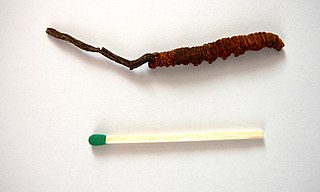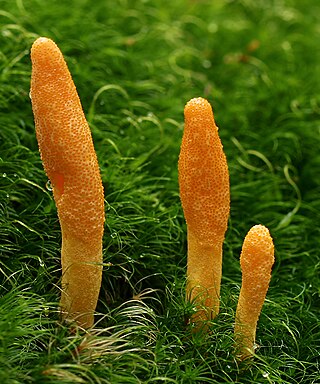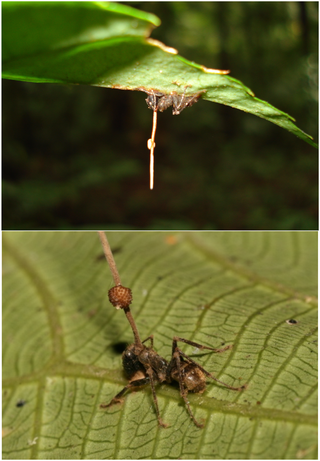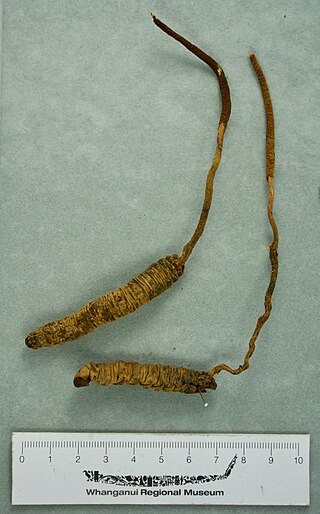
Ophiocordyceps sinensis, known colloquially as caterpillar fungus, is an entomopathogenic fungus in the family Ophiocordycipitaceae. It is mainly found in the meadows above 3,500 metres (11,500 ft) on the Tibetan Plateau in Tibet and the Himalayan regions of Bhutan, India, and Nepal. It parasitizes larvae of ghost moths and produces a fruiting body which is valued in traditional Chinese medicine as an aphrodisiac. Caterpillar fungus contains the compound cordycepin, an adenosine derivative. However, the fruiting bodies harvested in nature usually contain high amounts of arsenic and other heavy metals, so they are potentially toxic and sales have been strictly regulated by China's State Administration for Market Regulation since 2016.

Cordyceps is a genus of ascomycete fungi that includes about 600 worldwide species. Diverse variants of cordyceps have had more than 1,500 years of use in Chinese medicine. Most Cordyceps species are endoparasitoids, parasitic mainly on insects and other arthropods ; a few are parasitic on other fungi.
Thitarodes is a genus of moths of the family Hepialidae. In English Thitarodes is known as "ghost moth". They are found in eastern Asia. The majority are restricted to the Tibetan Plateau. Often in Chinese entomological nomenclature Thitarodes is still referred to as Hepialus, although the name was changed back in 1968. Furthermore, some authors use incorrectly the term "bat moth" which is a bad translation of the Chinese term for ghost moth.

Cordycepin, or 3'-deoxyadenosine, is a derivative of the nucleoside adenosine, differing from the latter by the replacement of the hydroxy group in the 3' position with a hydrogen. It was initially extracted from the fungus Cordyceps militaris, but can now be produced synthetically. It is also found in other Cordyceps species as well as Ophiocordyceps sinensis.

Beauveria is a genus of asexually-reproducing fungi allied with the ascomycete family Cordycipitaceae. Its several species are typically insect pathogens. The sexual states (teleomorphs) of Beauveria species, where known, are species of Cordyceps.

Ophiocordyceps unilateralis, commonly known as zombie-ant fungus, is an insect-pathogenic fungus, discovered by the British naturalist Alfred Russel Wallace in 1859, and currently found predominantly in tropical forest ecosystems. O. unilateralis infects ants of the tribe Camponotini, with the full pathogenesis being characterized by alteration of the behavioral patterns of the infected ant. Infected hosts leave their canopy nests and foraging trails for the forest floor, an area with a temperature and humidity suitable for fungal growth; they then use their mandibles to attach themselves to a major vein on the underside of a leaf, where the host remains after its eventual death. The process, leading up to mortality, takes 4–10 days, and includes a reproductive stage where fruiting bodies grow from the ant's head, rupturing to release the fungus's spores. O. unilateralis is, in turn, also susceptible to fungal infection itself, an occurrence that can limit its impact on ant populations, which has otherwise been known to devastate ant colonies.

Ophiocordyceps is a genus of fungi within the family Ophiocordycipitaceae. The widespread genus, first described scientifically by British mycologist Tom Petch in 1931, contains about 140 species that grow on insects. Anamorphic genera that correspond with Ophiocordyceps species are Hirsutella, Hymenostilbe, Isaria, Paraisaria, and Syngliocladium.

Isaria sinclairii is a species of entomopathogenic fungus mostly infecting the underground nymphs of cicadas. It produces myriocin, from which the synthetic drug fingolimod, a treatment for multiple sclerosis, was developed.
Thitarodes namnai is a species of moth of the family Hepialidae. It is found in Bhutan.
Thitarodes namlinensis is a species of moth of the family Hepialidae. It is found in China.

Ophiocordyceps nutans is an entomopathogenic fungus belonging to the order Hypocreales (Ascomycota) in the family Ophiocordycipitaceae. O. nutans only parasitizes Hemipterans, namely stinkbugs. In Korea, O. nutans is one of the most common species of Cordyceps. O. nutans, as well as other Cordyceps species, are mainly classified morphologically by their colour, fruit body shape, and host insect species. Stinkbugs cause considerable damage to agriculture and forestry, and the anamorph of O. nutans, Hymenostilbe nutans, is a potential selective biological control agent against the stinkbugs.
Ophiocordyceps myrmecophila, commonly known as the ant fungus or ant eater, is a species of fungus that parasitizes insect hosts, in particular members of the order Hymenoptera.

Cordyceps militaris, commonly known as the caterpillar fungus, is a species of fungus in the family Cordycipitaceae, and the type species of the genus Cordyceps, which consists of hundreds of species. The species was originally described by Carl Linnaeus in 1753 as Clavaria militaris. Cordyceps militaris parasitizes insects and is used in traditional Chinese medicine and modern pharmaceuticals.

Ophiocordyceps formicarum is an entomopathogenic fungus belonging to the order Hypocreales (Ascomycota) in the family Ophiocordycipitaceae. The fungus was first described by mycologist George S. Kobayashi in 1939 as a species of Cordyceps. Originally found in Japan growing on an adult Hercules ant, it was reported from Guizhou, China, in 2003. It was transferred to the new genus Ophiocordyceps in 2007 when the family Cordycipitaceae was reorganized. A technique has been developed to grow the fungus in an agar growth medium supplemented with yeast extract, inosine, and glucose.

Ophiocordyceps sphecocephala is a species of parasitic fungus. It is entomopathogenic, meaning it grows within insects, particularly wasps of the genera Polistes, Tachytes, and Vespa. It has been reported across the Americas and China.

Ophiocordyceps robertsii, known in New Zealand as vegetable caterpillar is an entomopathogenic fungus belonging to the order Hypocreales (Ascomycota) in the family Ophiocordycipitaceae. It invades the caterpillars of leaf-litter dwelling moths and turns them into fungal mummies, sending up a fruiting spike above the forest floor to shed its spores. Caterpillars eat the spores whilst feeding on leaf litter to complete the fungal life cycle. Evidence of this fungus can be seen when small brown stems push through the forest floor: underneath will be the dried remains of the host caterpillar. This species was first thought by Europeans to be a worm or caterpillar that burrowed from the top of a tree to the roots, where it exited and then grew a shoot of the plant out of its head. It was the first fungus provided with a binomial name from New Zealand.

Cordyceps gunni is a species of fungus in the family Cordycipitaceae, and is of the genus Cordyceps. It was originally found and recorded by Gunn in Tasmania and named as Sphaeria gunnii and later moved into the Cordyceps genus and renamed Cordyceps gunnii. This fungus and its sisters in the genus Cordyceps are known for growing out of insect bodies. C. gunnii can be found at ground level poking out of caterpillar burrows, attached to a caterpillar's head.

Thitarodes shambalaensis is a species of moth of the family Hepialidae. It was described by Zhengyang Wang, along with Hailing Zhuang, Min Wang, and Naomi E. Pierce in 2019, and is known from Sichuan, China from the Tibetan Plateau, where it was found on the Yanzigou glacial valley, Mt. Gongga. It was differentiated as a new species using morphological and genetic evidence, including genome-wide analysis of SNPs and COI barcodes. Notably, this species is a host for the caterpillar fungus Ophiocordyceps sinensis, which is economically important for its use in traditional herbal medicine. This fungus is in decline due to overharvesting and climate change. Species in the genus Thitarodes are largely unknown due to logistical difficulties in collecting adult, male specimens, correct identification of their genitalia, and lack of accessible holotypes.

Isaria cicadae is an ascomycete fungus that parasitizes cicada larvae. It forms white and yellow asexual fruiting structures resembling synnema. While mostly being found throughout Asia in warm, humid regions, it has been found on various other continents. It is known in Traditional Chinese Medicine as Chan Hua and commonly called “cicada flower.” Its medicinal uses date back to the fifth century AD in China. It can also be used in various foods and tonics.

Ophiocordyceps dipterigena is an entomopathogenic fungi species from the genus Ophiocordyceps. This species was originally described in 2007.













